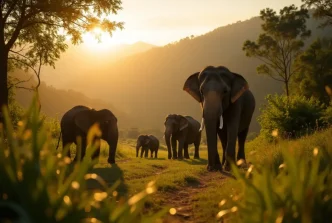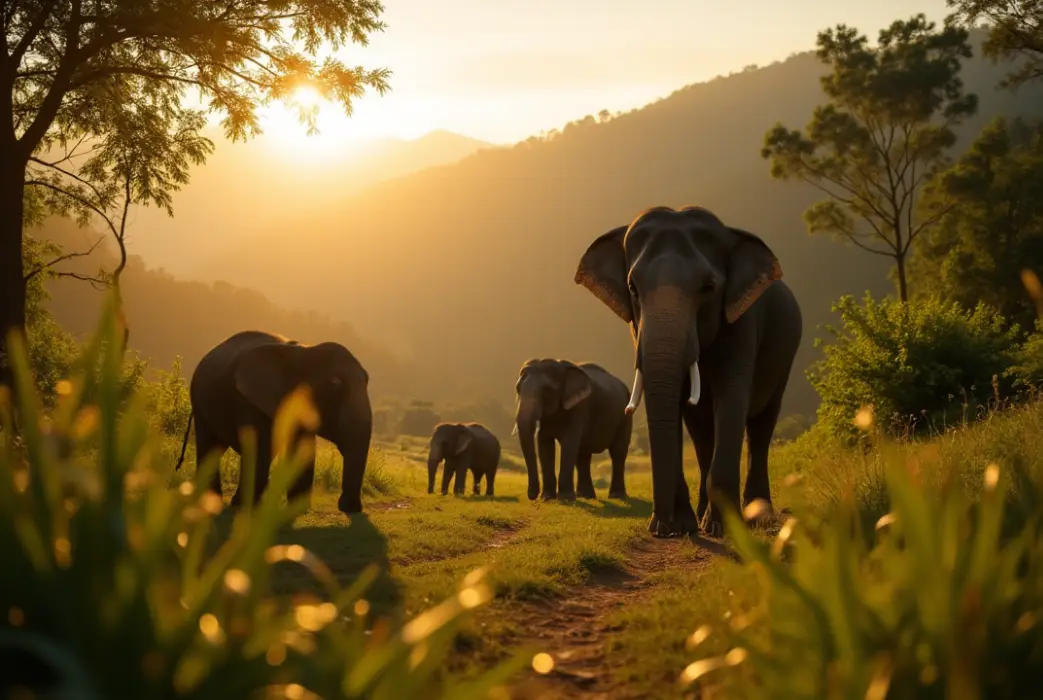In the lush landscapes of northern Thailand, elephant camps—long a cornerstone of the country’s tourism industry—are grappling with an uncertain future. In Chiang Mai province, facilities like Mae Taeng Elephant Park are facing a barrage of economic pressures, from dwindling tourist numbers to soaring operational costs. Yet, amidst these challenges, a transformation is underway, as camps pivot from traditional entertainment to educational tourism in a bid to sustain both their elephants and the communities that depend on them.
A Perfect Storm of Challenges
Thailand’s elephant camps, particularly in Chiang Mai, have historically drawn millions of visitors with their iconic shows and elephant rides. However, a confluence of crises has slashed visitor numbers and pushed the industry to the brink. Natural disasters, including flooding and earthquakes in late 2024, have deterred travelers, with arrivals dropping by as much as 50 percent in some periods. Seasonal variations exacerbate the struggle, with September often referred to as the “month of hunger” by operators due to low tourist turnout. Economic downturns, both globally and within Thailand, have further strained budgets, as fewer people can afford leisure travel. Even environmental factors, such as annual haze pollution, have played a role, though early rains this year offered some reprieve.
The lingering effects of the COVID-19 pandemic remain a heavy burden. During the height of the crisis, many camp operators were forced to sell personal assets—homes, cars, and savings—to keep their facilities afloat. Now, with tourism recovering at a sluggish pace, the industry faces a new reality: adapting to survive. At Mae Taeng Elephant Park, one of the region’s oldest and most established camps, the daily cost of caring for its 62 elephants is staggering. Each animal consumes around 500 Thai Baht (US$14) worth of food daily, amounting to monthly expenses of 300,000 to 400,000 Thai Baht (US$8,400 to US$11,200) for food alone.
From Entertainment to Education
In response to these challenges, Mae Taeng and its sister program, “Hug Elephant,” have embraced a significant shift in focus. While traditional activities like elephant rides and shows remain, the camp has expanded its educational offerings over the past decade. The Hug Elephant program, priced at 1,650 Thai Baht (US$46) per visitor, provides a five-station experience where guests don mahout clothing and engage directly with the animals. Activities include preparing health supplements, crafting herbal soap, feeding, and bathing the elephants—offering a hands-on understanding of their care.
This educational pivot is not just a survival tactic; it reflects a broader change in tourist expectations. International visitors, who make up the majority of the camp’s clientele, increasingly seek meaningful, ethical interactions with elephants rather than purely entertainment-focused experiences. The program features elephants comfortable with human contact, including a young social media star named Phu Pink, whose 150,000 followers have helped draw attention to the camp. Phu Pink’s past participation in a challenge with celebrity Jackson Wang further underscores the camp’s efforts to blend tradition with modern appeal.
Strategic Moves to Revive Tourism
Beyond educational programs, Mae Taeng and other camps are employing a multi-pronged strategy to attract visitors. Collaboration with the Tourism Authority of Thailand has been key, particularly in targeting the Chinese market, which historically accounts for 70 percent of their guests. The camp has also established promotional booths in nearly 10 countries, including Singapore, Malaysia, Taiwan, and the Philippines, to forge connections with international tour agents. Locally, partnerships with Chiang Mai’s tourism industry council and business associations provide mutual support during lean times.
In a unique display of cultural diplomacy, Mae Taeng is set to host elephant-back weddings for three American couples in June 2025. The event, which will feature coverage by US media and involvement from Thai embassy representatives, aims to showcase Thailand’s cultural heritage as a form of “soft power.” Such initiatives not only boost visibility but also position the camps as ambassadors of Thai tradition on a global stage.
Community at the Heart of Operations
The economic struggles of elephant camps extend beyond the animals to the human communities they support. Mae Taeng employs around 300 staff, including restaurant workers, mahouts, raft guides, drivers, housekeepers, and cooks. Many employees hail from the Karen long-neck village community, a minority group in northern Thailand. The camp provides housing, utilities, and rice for a modest fee of 4,000 Thai Baht (US$112) per month, ensuring a degree of stability for its workforce even during tough times.
Before the pandemic, Mae Taeng welcomed up to 2,700 visitors daily during peak seasons from October to March. Today, numbers hover at 200 on weekdays and 700 to 1,200 during high season weekends—a stark decline that impacts both revenue and employee livelihoods. The camp’s efforts to diversify income, such as offering non-elephant activities like ox-cart rides and bamboo rafting on the Mae Taeng River, aim to bolster financial resilience while maintaining cultural authenticity.
Changing Demographics and Domestic Outreach
The demographic makeup of visitors to Chiang Mai’s elephant camps highlights both opportunities and challenges. International tourists from Taiwan, Singapore, Malaysia, Europe, the Americas, Australia, the Middle East, and Israel dominate, with growing interest from South Korea, Spain, France, and Italy in recent years. By contrast, Thai visitors account for just 10 percent of guests, typically comprising elephant enthusiasts or corporate groups. To boost domestic tourism, Mae Taeng has introduced special pricing for Thai elephant followers and leveraged “elephant influencers” on social media to capture local interest.
This disparity reflects broader trends in Thailand’s tourism landscape, where international markets often drive recovery while domestic travel lags amid economic constraints. For camps like Mae Taeng, striking a balance between catering to foreign visitors and cultivating a local audience remains a delicate task, especially as operating costs continue to outpace revenue.
A Model for the Future?
The shift from entertainment to education at Thailand’s elephant camps may signal a new direction for the industry. As global attitudes toward animal tourism evolve, with greater emphasis on ethical treatment and conservation, programs like Hug Elephant could set a precedent for sustainable practices. However, the road ahead is far from certain. The camps must navigate not only economic headwinds but also changing tourist expectations in a post-pandemic world.
For now, Mae Taeng’s adaptations—educational tourism, international outreach, and cultural initiatives—offer a glimmer of hope. Whether these strategies will suffice to weather ongoing challenges remains an open question. As Thailand’s tourism sector inches toward recovery, the resilience of Chiang Mai’s elephant camps could serve as a litmus test for the broader industry, balancing cultural heritage with modern demands in an increasingly complex global market.
As these iconic attractions redefine their purpose, the bond between humans, elephants, and the communities that sustain them endures—a testament to adaptability in the face of adversity.
















